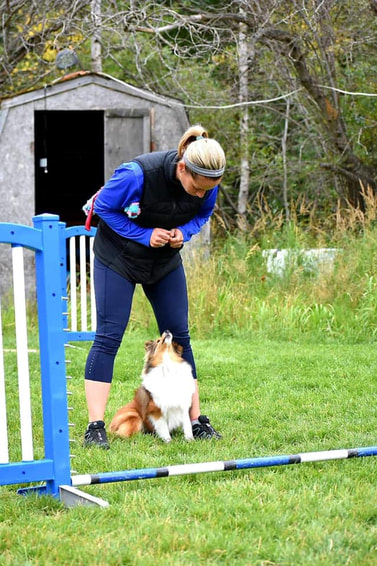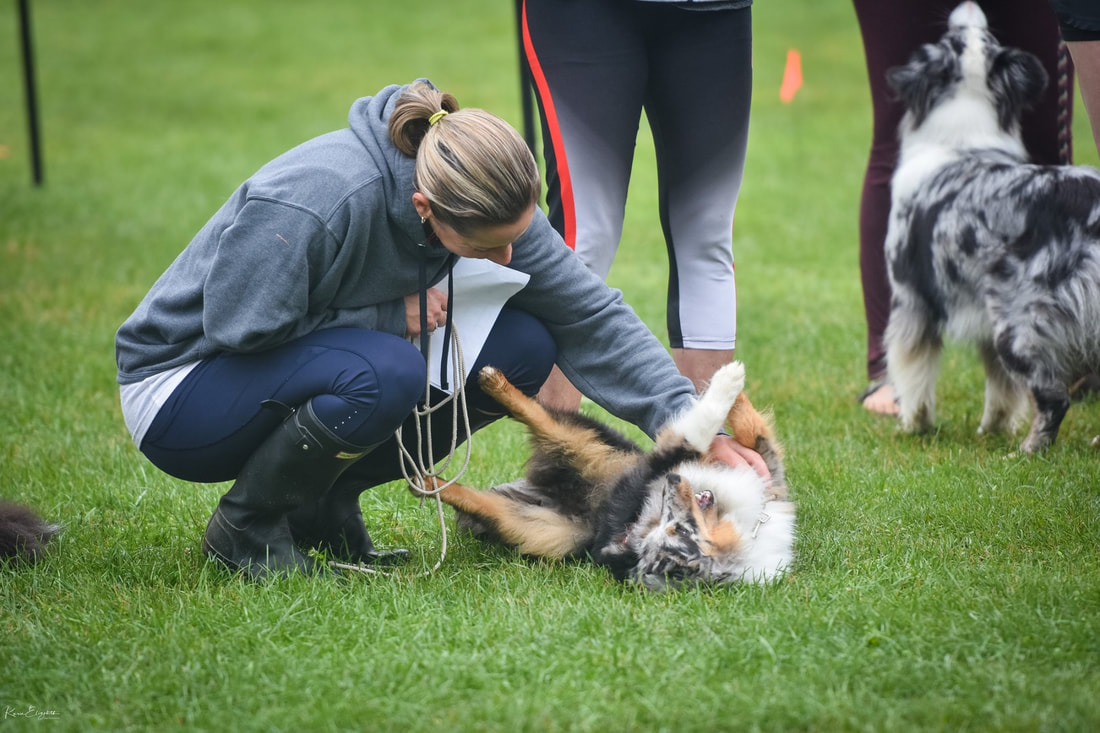|
Have you ever gotten SUPER frustrated when training? Have you ever found yourself saying, "We'll never get this!" Have you ever felt that you're seeing no progress towards success? Our mindset has a big impact on our ability to be successful and what we choose to do in our life. It can either increase our sense of confidence and push us to achieve our goals or it can really undermine us. In this week’s blog I take a look at the other end of the leash explore how we can make our failures WORK for us! Hardwired to Remember FailureHumans are actually hardwired to remember negative thoughts, emotions, and experiences better than positive ones! When we “fail” at something there is a series of chemical reactions that occur in the brain – namely, the release of cortisol. Cortisol is the body’s main stress hormone and is the hormone responsible for triggering out “fight or flight” impulse. The brain also handles positive and negative information in different hemispheres. Negative emotions generally involve more thinking, and the information is processed more thoroughly than positive ones. From an evolutionary point, our ability to remember negative or bad things would have also resulted in a greater chance in survival because we would be less likely to make the same mistakes. Our ability to remember failure also means that in dog training we’ll also remember more often the past mistakes we’ve made or the challenges we faced. When I speak to my students, they will often dwell on what went wrong in a session rather than acknowledge what went well! They’ll also often play down the success they’ve had or completely forget the progress they’ve made! What does failure really mean?When we have a failure in dog training it is nothing more than information letting us know what is not working at this stage in training. Failure is not terminal!! Get comfortable being scared – it's okay to be uncertain about how to proceed with things so don’t let this intimidate you into training paralysis. We work very hard to teach our dogs to recover from failure and we need to work hard to do this same. Use your resources available, this is why we have people around us to help, try speaking with a friend or trainer to work through your uncertainty. Let yourself be imperfect and don’t be afraid to fail. Don’t expect all your attempts to change habits to be successful immediately. In fact, it is accurate to say that we fail our way to success. We will have setbacks and hiccups but by working together and pushing forward we end up achieving our goals! Failure is as much a part of your journey to extraordinary results as success. Failure is a key part of the learning process and if we’re not failing, chances are, we’re not trying new things or taking that next needed step to progress our goals. This is how we grow as trainers and learn to adapt our training style to each individual dog. For a time, I really struggled with failure when working on conditioning with my young dog Keeper. Every time we entered the conditioning room Keeper was jumping into all the equipment as fast as she could to try to “earn” the cookies. In no way listening to what I was asking for her to do. Not only was this not a safe way to engage equipment but I was not able to control the environment and allow her to be successful by focusing on me and what I wanted her to do. While I was happy that she wanted to work and was excited to do so I needed her to focus more on me and be able to perform the equipment when and I how I asked her to do. This was very frustrating. So, I decided that it was in both of our best interest to change the focus of our sessions. Taking a break from actual conditioning and layering back to teach her to focus on engagement with me in the conditioning room. Could Keeper just walk into the conditioning room and pay attention to me and not the equipment? After a couple of weeks with this as the plan we were then able to get back to actual equipment and significantly lower the level of frustration for both of us. Regardless of the level of training knowledge in the handler and the level of drive in the dog we can still be challenged with failure. What we can do!Now that we know we’re more likely to remember our past failures what can we do to counteract our own biochemical responses? The reality is, we’ll probably have the base impulse to shortchange our success and emphasize our failures BUT that’s doesn’t mean we give up completely! So what can we do now? Break it down! One of the things you can change in your training sessions to build more success is being a splitter not a lumper. This means breaking down the exercise into its smallest components and building them up into the complete behaviour. In canine conditioning, I tell my students that if they’re not finding success within the first couple of reps then it’s time to re-evaluate and break down the exercise into smaller parts! We want to build behaviours brick by brick creating a strong structure not dump a pile of bricks all together and hope they don’t fall down. Equipment set ups can be another way we can break down the behaviour. We want to make sure we protect the dog's confidence and start with a $5000 bet. Meaning you would bet $5000 you dog could be successful on this piece of equipment the first time. It is more important to start with an equipment set up that might be a bit below their ability starting with success and confidence then adding challenges a little at a time as the session progresses. An example of this would be if you were attempting to teach your dog to retrieve a specific toy. You would not start off teaching this will the challenge of 10 different toys to choose from. You would start with 2 choices to help set your dog up for success from the start and slowly build the challenges by adding more toys. Focus on good handler mechanics Things such as placement of reward or handler physical pressure can help or hinder success in any conditioning session. If you are getting failure in a session, think about how you might could change your handler mechanics to allow the dog to make steps in the right direction. An example of this would be if you were trying to get a nice tuck sit but your dog is reluctant to pop up onto the platform. It is possible that your physical pressure might be causing your dog to be reluctant to move forward, so a simple change in handler position might fix the issue. Plan your sessions It sounds simple and it is but many skip the step of planning your session before you actually start with the dog. Having a solid plan for the session will allow you to make better choices during the session and the steps you can take to build success. If revisiting an exercise that you have done in a previous session it is also helpful to review both the successes and the challenges you had in that previous session to better build up more success. Another part of planning your session is selecting the right training environment to make sure your dog can perform at their best. Keeping the level of distraction low and making sure you have the physical space and a non-slip flooring for the work you are going to be doing will also build a stronger level of success in any conditioning session. Walk away if you cannot manage your frustration It is ok just to end the session!! Rather than let frustration get the best of you, recognize that some times and some days just aren't working for us - this has nothing to do with our dogs or training ability! It is always best if you are getting frustrated to just take a break, play with your dog or simply put the training on pause for another time. This is the best way to keep from building up more frustration for both you and your dog. Build a growth mindset - Our mindset has a huge impact on our success and what we choose to do in our life. It can either add to our sense of confidence and really push us to achieve our goals or it can create doubt in our ability and maybe cause us to just walk away. People with a growth mindset believe that their most basic abilities can be developed through dedication and hard work. A growth mindset develops a passion for learning and allows you to not get discouraged by failure but rather see it as an opportunity to learn and grow. How do we cultivate a growth mindset?
Some final thoughts...Remember, in canine conditioning, because we’re often making small incremental changes, it can be difficult to keep track of successes and see the progress made over time. That’s why I want to issue a challenge! For the next month, let's keep a training journal. In that journal at the end of each session I want to you to start the entry with at least 5 successes you had in that session. These can be either your success as a trainer or your dog's success with a behaviour. If you struggle with this, remember it’s not bragging, this journal is for your eyes only. Then the next session where you hit a stumbling block or get frustrated, I want you to go back to that journal and read all those positive successes you have had in previous sessions. Please take a moment right now and share a recent success you and your dog has had in the comments below! SourcesTugend, Alina. “Praise Is Fleeting, but Brickbats We Recall,” The New York Times (2012), https://www.nytimes.com/2012/03/24/your-money/why-people-remember-negative-events-more-than-positive-ones.html
4 Comments
Norma Nelson-Lomoro
3/19/2021 09:48:42 am
Great advice. Thanks for the reminder!
Reply
Becky McMahon
3/19/2021 10:22:17 am
Miki and I are working on some obstacle discrimination with a straight tunnel and a nearby dog walk. Sending from 3 jumps away didn't work so we tried two jumps away, still too hard so we tried one jump away. Success. I then went back to 2 jumps away and again success. Then a short sequence with 3 jumps and we were on our way. Next time we cued the dog walk and that was great too. I'm so proud of my little guy. He's learning to listen and now I have to be careful to keep my cues consistent because that's what he expects!! Sometimes I'm not sure who is training who.
Reply
Pat Burroughs
3/19/2021 04:46:04 pm
I have been working on the proper stack with 2 flat pieces of wood about 16” long by about 12” wide both my dogs understood to put their front feet on but struggles with back feet ,after practicing short little sessions yesterday they both started correcting their back feet on their own that made me happy still a lot to work on but little step no pun intended lol
Reply
Katherine
4/14/2023 08:49:21 pm
Windsor and I have been working for quite some time on building his tugging drive for the times when I initiate a tug. This is important for his focus in in his drive to toy games. Today was the very first time in nearly a year of practice when he jumped in to tug on my first invitation! So happy I got it on video! This was a great blog. Thank you. I am a firm believer in the importance of recognizing what mindset you’re in and working towards developing a mindset designed to create success.
Reply
Leave a Reply. |
AuthorCarolyn McIntyre Archives
March 2024
Categories
All
|




 RSS Feed
RSS Feed